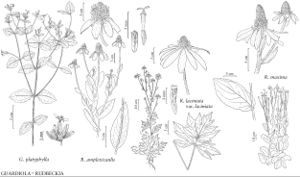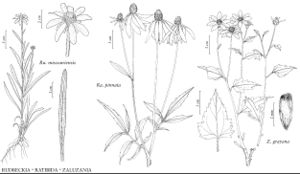Rudbeckia
Sp. Pl. 2: 906. 1753.
Gen. Pl. ed. 5, 387. 1754.
Annuals, perennials, subshrubs, or shrubs [perennials], mostly 10–80 (–200) cm. Stems erect, branched distally or ± throughout. Leaves cauline; mostly opposite (distal sometimes alternate); petiolate or sessile; blades mostly lanceolate to oblanceolate overall, usually 1–3-pinnately lobed or pinnatisect, ultimate margins toothed or entire, faces glabrous or hairy (oil-glands scattered and/or submarginal). Heads radiate or discoid, borne singly or in ± corymbiform arrays. Calyculi 0. Involucres narrowly cylindric or fusiform to turbinate or broadly campanulate, 1–12+ mm diam. Phyllaries persistent, 3–21+ in 1–2 series (connate to 7/8+ their lengths, usually streaked and/or dotted with oil-glands). Receptacles convex to conic, smooth or finely pitted, epaleate. Ray-florets 0 or 1–8 (–13+) (to 100+ in “double” cultivars), pistillate, fertile (except “double” cultivars); corollas yellow or orange, redbrown (with or without yellow/orange), or white. Disc-florets 6–120+, bisexual, fertile; corollas greenish yellow to orange, sometimes tipped with red or redbrown, tubes much longer than or about equaling funnelform throats, lobes 5, deltate to lance-linear (equal or 2 sinuses deeper than others). Cypselae narrowly obpyramidal or fusiform-terete, sometimes weakly flattened, glabrous or hairy; pappi persistent, of 2–5 (–10) dissimilar, distinct or connate scales in ± 1 series: 0–5+ oblong to lanceolate, erose-truncate or laciniate plus 0–2 (–5) longer, subulate to aristate. x = 12.
Distribution
North America, in Europe
Discussion
Species 23 (23 in the flora).
The species of Rudbeckia are distributed among three major clades or lineages. Although relationships among the lineages are not robustly resolved, the lineages are treated here as sections (as they have been traditionally). Rudbeckia hirta and sometimes other species of the genus are used in experimental studies relating to initiation of flowering and hairy root culture. Most species are rich sources of phytochemicals that may offer potential for pharmaceutical or other uses.
Selected References
Key
| 1 | Annuals (stems glabrous); leaves sessile, blades elliptic, lanceolate, oblanceolate, oblong, or ovate (not lobed, bases auriculate and clasping, faces glabrous, glaucous); phyllaries in 2 series (lengths of outer 2–4+ times inner, inner sometimes interpreted as paleae); paleae surpassing cypselae, margins ciliate, faces usually glabrous; pappi 0 | Rudbeckia sect. Dracopis |
| 1 | Annuals, biennials, or perennials (if epappose annuals, stems hairy); leaves petiolate or sessile, blades elliptic, lanceolate, linear, oblanceolate, ovate, or spatulate (often lobed, faces glabrous or hairy, sometimes glaucous; if leaves sessile and not lobed and bases auriculate and clasping, then robust perennials); phyllaries in 2(–3) series; paleae sometimes surpassing cypselae, margins usually ciliate, rarely eciliate, faces glabrous or hairy; pappi usually coroniform or of 2–6+ scales, sometimes 0 (sometimes cypselae each with glandular hairs around apices in R. heliopsidis) | > 2 |
| 2 | Leaves often bluish green, glaucous; receptacles usually conic to columnar (paleae not surpassing cypselae, except in R. laciniata: paleae surpassing cypselae, receptacles sometimes hemispheric to ovoid, disc corolla lobes yellow); ray florets 0 or 8–15+, corollas bright yellow; disc corollas proximally yellow to yellowish green, distally yellow or greenish to brown-purple; cypselae (3–)3.5–7.5 mm; pappi coroniform, or of 2–6 scales 0.1–2.5 mm | Rudbeckia sect. Macrocline |
| 2 | Leaves green, not glaucous; receptacles usually conic to hemispheric, rarely columnar (paleae surpassing cypselae); ray florets 6–25+, corollas usually yellow-orange proximally, yellow distally, sometimes with basal maroon splotch (orangish red to maroon in R. graminifolia); disc corollas proximally yellow to yellowish green, distally usually brown-purple, lobes sometimes yellowish or greenish; cypselae 1.5–3.5(–4) mm; pappi coroniform, or of 8+ unequal scales 0.1–2 mm, or 0 (sometimes cypselae each with glandular hairs around apices in R. heliopsidis) | Rudbeckia sect. Rudbeckia |

